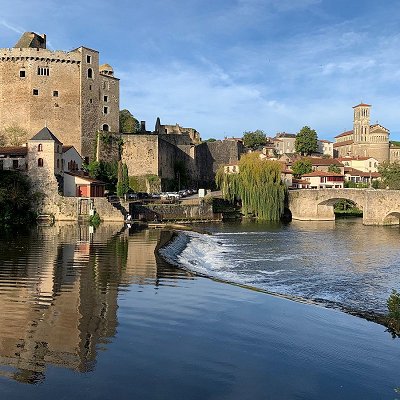
Like us on Facebook
PLACE NAMES



|
|
Clisson
|
 |
|
Clisson is a commune in the Loire-Atlantique department in the Pays de la Loire region in western France.
It is situated at the confluence of the Sèvre Nantaise and the Moine 17 miles (27 km) southeast of Nantes.
The town and the celebrated family of Clisson (the most famous members are Olivier IV de Clisson and Jeanne de Clisson) take their name from their stronghold. Clisson has its imposing ruins, parts of which date from the thirteenth century.
The town and castle, the château de Clisson, were destroyed in 1792 and 1793 during the War in the Vendée.
Afterwards, the sculptor François-Frédéric Lemot bought the castle, and the town was rebuilt in the early part of the 19th century according to his plans. There are picturesque parks on the banks of the rivers. The Moine is crossed by an old gothic bridge and by a fine modern viaduct.
The Château stands on the right bank of the Sèvre Nantaise. Within then independent Brittany, the castle, situated at a crossroads for Anjou and Poitou, was one of the great fortified places on the frontiers of the Duchy of Brittany
The first Lords of Clisson occupied the site from the 11th century. They are mentioned for the first time in 1040. Clisson was then the seat of a powerful châtellenie covering 23 parishes.
Most of the present castle was built in the 13th century. Its form at that time was an irregular polygon flanked by round towers and isolated from the rocky plateau by a shallow moat. In the 14th century, Olivier III de Clisson incorporated the gatehouse into a massive quadrilangular keep. The two semicircular towers of the gatehouse collapsed in the 17th century. The castle became the setting for the turbulent lives of Olivier IV de Clisson and Olivier V de Clisson, named Constable of France in succession to Du Guesclin in 1380. The castle is said to be haunted by Jeanne de Clisson wife of Olivier IV.
In the 15th century, the fortifications were modernised to permit the use of artillery. In the second half of the century, the former entrance was modified and the curtain wall was extended and completed by a barbican. At the same time, the castle was enlarged to the west with a new rectangular enclosure nearly 100 m long, armed with towers with artillery casemates.
After 1420, the castle became the property of the Duke of Brittany. It was one of the favourite residences of Duke Francis II who was remarried there, to Marguerite de Foix in 1474. He built a second rectangular enceinte flanked by artillery towers. Around 1590, the troubled period of the French Wars of Religion necessitated the construction of three terraced bastions on the south. Thus, three lines of defence in depth protected the site.
Until the 17th century, the castle was the residence of the Avaugour family, descendants of François Ier d'Avaugour, illegitimate son of François II. He modified and transformed the castle to suit the tastes and fashions of the day.
The remains of the castle were classed as a monument historique by a French Ministry of Culture decree of 13 August 1924. In 1962, the castle was sold by the Lamot family to the Conseil général of the Loire-Atlantique, who carried out important restoration works with the assistance of the French Ministry of Culture.
 Feel free to Email me any additions or corrections Feel free to Email me any additions or corrections
LINKS AVAILABLE TO YOUR SITE
| | |





